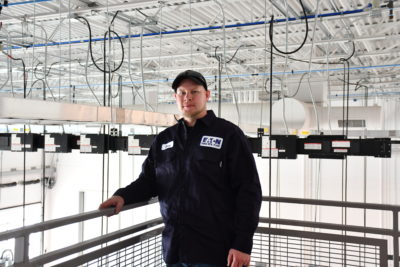

|
|
There’s a reason they’re called community colleges.
Stanly Community College (SCC), about an hour east of Charlotte, serves a population of just under 64,000. The way its leaders see it, basically everything the college does comes back to the community — what will help residents find good-paying jobs, and what will attract and serve local businesses.
In the 2018-19 fiscal year, SCC added $70.2 million in income to the local community’s economy.
The college was one of the last to join the system of 58, President Dr. John Enamait said. He calls it “the little college that could.” And a lot of hard work and relationship building goes into that.
The college’s leaders meet with not only its Board of Trustees but also an advisory board. It offers many of the same services that communities associate with community colleges, such as a small business center and customized training for businesses. It also has articulation agreements with several universities, including Wingate University, East Carolina University, Montreat College, and the University of Mount Olive.
Jeff Parsons, vice president of academic affairs, said feedback from the public empowers the college to truly meet local needs.
“It’s that community part of the community college that really makes that possible,” he said.


According to its economic impact report, the college supports one of every 16 jobs in the county. One of the big ways it’s able to do that is by working with local companies, both to provide customized training and to align course offerings with business needs.
“We work not just to train the employees of the companies for the needs that the company has, but to also train those people where they’ll have life skills, and transferable skills that they can carry with them through life,” said Krista Bowers, economic and workforce development director for the college.
The college works with a variety of companies, including Michelin, Fiberon, Carolina Paper Converters, and United Protective Technologies.
Having that impact requires close and consistent communication. The college held industry forums 10 years ago, leaders said, which helped them expand and reform their facilities. For example, the college’s IT facility now trains people from 48 countries, Parsons said.




Bowers said the partnership has reached a point where companies will call department leaders at the college asking for recent graduates, and the college will adjust course offerings to align with industry needs.
This collaboration provides opportunities for apprenticeships as well as job placements for students. Bowers highlighted two female students who came to SCC through Career and College Promise before graduating with welding associate degrees.
“Then they both were hired on at Martin Sprocket, which is one of our companies, as the first female welders in that company,” Bowers said. “Those girls are 19 and 17 years old, and are working full time. Full benefits, starting out at $20 to $22 an hour. For Stanly County, that’s huge.”


That’s huge not just for the employees, but for the college’s community. The college really tries to entice students to stay in the county after graduating to keep the local economy growing.
That’s where they really see the return on their investment that the economic impact reports talk about.
Meeting needs also requires investments in facilities, and Stanly Community College is growing. It’s building a trade center on campus, which will house such programs as HVAC, welding, and machining. The project should be finished in early 2024, with classes starting in fall 2024.
Enamait said that when he became president, the college was talking about starting a culinary program. But where would its students find jobs locally? Ultimately, he said, they decided it would actually help students find higher-paying jobs.
He also said this expansion is a way to attract more residents who may not want a four-year degree, or what’s currently being offered at the college.
“We’re hoping that we’re able to attract them so that they can get some higher education to ultimately lead to a higher economic mobility,” he said. “The Charlotte region is one of the worst in the country for economic mobility, and we’re really trying to affect that change.”


It’s the local nature of a community college that makes all of this possible, from the collaboration to student outcomes. The college works with local government, the community, and the school district to provide opportunities to residents.







